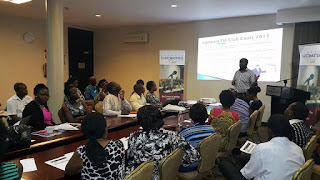Everyday, we seek opportunities to articulate ourselves better. Our Vice President Education , Gilbert Rutebemberwa, shares ways of navigating this ordeal from information on the Toastmasters international website.
 |
| A Kampala meeting |
PUBLIC
SPEAKING TIPS
SUCCESSFUL SPEECHES
Whether you're talking to a small
group of people or speaking to a large audience, you want to be sure your
speech is memorable and enjoyable. Follow these five easy tips to help ensure
your speech delivers:
·
Be prepared. Your audience is giving you their time and consideration, so rehearse
enough to be confident you'll leave a good impression.
·
Start strong. Begin your speech with a powerful opening that will grab your audience's
attention, such as a startling fact or statistic, an interesting story or a
funny joke.
·
Be conversational. Avoid reading your speech word for word. Instead, refer to notes or
points from an outline to help your speech have a more free-flowing,
conversational tone.
·
Speak with passion. If you're truly invested in what you're saying, you'll be better able to
keep your audience's attention.
·
Be patient. It's easy to get frustrated if you make a mistake. But remember that
public speaking is not easy and it takes time to hone your skills. Keep practicing
and you will reach your goals.
1.
PREPARING A SPEECH
Preparing for a speech is one of the best
ways to ensure you give an effective presentation. Try these tips to help you
properly prepare:
- Organize your speech in a logical sequence: opening, main
points, summary.
- Practice and rehearse a speech frequently prior to
delivering it. Ask friends to be your audience, or practice in front of a
mirror. Be sure to use a timer to help you pace your speech.
- Become familiar with the stage or the setting where the speech will
take place. Get a sense of the size of the stage, where any steps or
obstacles might be, and where to enter and exit.
- Choose comfortable clothes to wear, but always maintain a professional
appearance.
- Visual aids should fit a speech, whether they are
funny, serious or technical. The main goal of visual aids is to help the
audience understand what is being said, and reinforce the points of a
speech in unique and interesting ways.
2.
GESTURES AND BODY LANGUAGE
Speakers generate a great amount of emotion
and interest through the use of non-verbal communication, often called gestures
or body language. A speaker's body can be an effective tool for emphasizing and
clarifying the words they use, while reinforcing their sincerity and
enthusiasm. Here are a few tips on how to use gestures effectively:
- Eye contact establishes an immediate bond with an
audience, especially when a speaker focuses in on individual listeners
rather than just gazing over the audience as a whole.
- Control mannerisms. Mannerisms are the nervous expressions a
speaker might not be aware of such as putting their hands in their
pockets, nodding their head excessively, or using filler words like um and ah too
often.
- Put verbs in to action when speaking to an audience by
physically acting them out with the hands, face or entire body.
- Avoid insincere gestures by involving the entire body as much
as possible in the movement and matching facial expressions to it.
- Move around the stage as topics change and move toward the
audience when asking questions, making critical connections, or offering a
revelation.
Submitted by Gilbert
Rutebemberwa,
Vice President Education 2016-2017,
Kampala Toastmasters.
Good one, it is a refresher on pointers we try and master as we go along the journey of becoming competent speakers. I like the advise to practice and rehearse in particular because as people accustomed to speaking or rather 'quick to speak' we take the art of giving speeches for granted. I also like the advise to control mannerisms! I wonder what mine are???? I seek to add, contiously avoid pause feelers, for fast or rushed speakers like myself pace yourself and lastly speak in your natural voice. 'Be yourself'
ReplyDeleteSorry the word is Consciously
DeleteSorry the word is Consciously
DeleteYesterday I attended an entrepreneur's training workshop or is the better term business mentoring workshop. A lady manager for a property company was requested to give a company pitch. After about Five mins into her pitch I understood why we need to be members of KTM club. The obvious difficulty in communicating by the property manager provided me with an occasion to speak about KTM.
ReplyDeleteYesterday I attended an entrepreneur's training workshop or is the better term business mentoring workshop. A lady manager for a property company was requested to give a company pitch. After about Five mins into her pitch I understood why we need to be members of KTM club. The obvious difficulty in communicating by the property manager provided me with an occasion to speak about KTM.
ReplyDeleteGood one, it is a refresher on pointers we try and master as we go along the journey of becoming competent speakers. I like the advise to practice and rehearse in particular because as people accustomed to speaking or rather 'quick to speak' we take the art of giving speeches for granted. I also like the advise to control mannerisms! I wonder what mine are???? I seek to add, contiously avoid pause feelers, for fast or rushed speakers like myself pace yourself and lastly speak in your natural voice. 'Be yourself'
ReplyDeleteThank you Gilbert for the tips.
ReplyDeleteWhen my mentor mentioned that I could rehearse infront of a mirror, I thought it was weird. But now I know it is a time-tested strategy that actually works